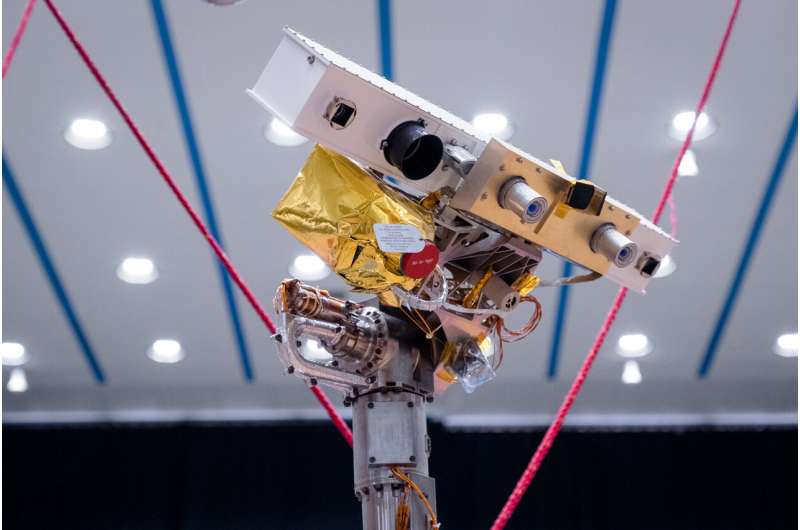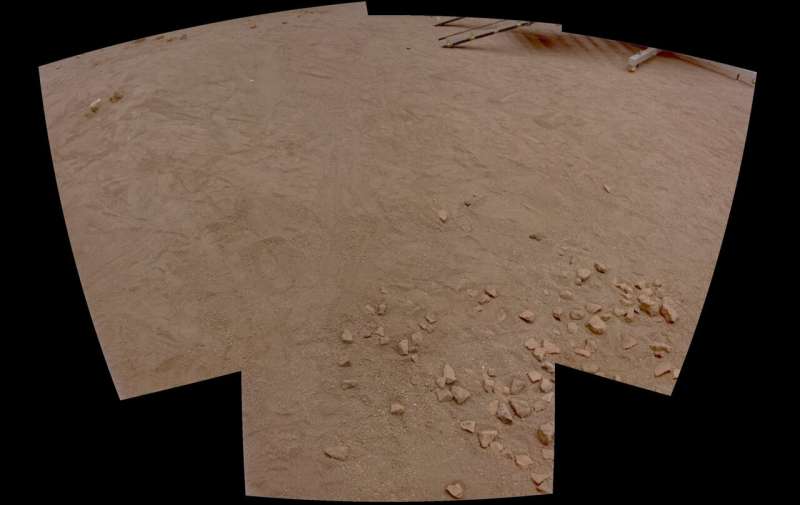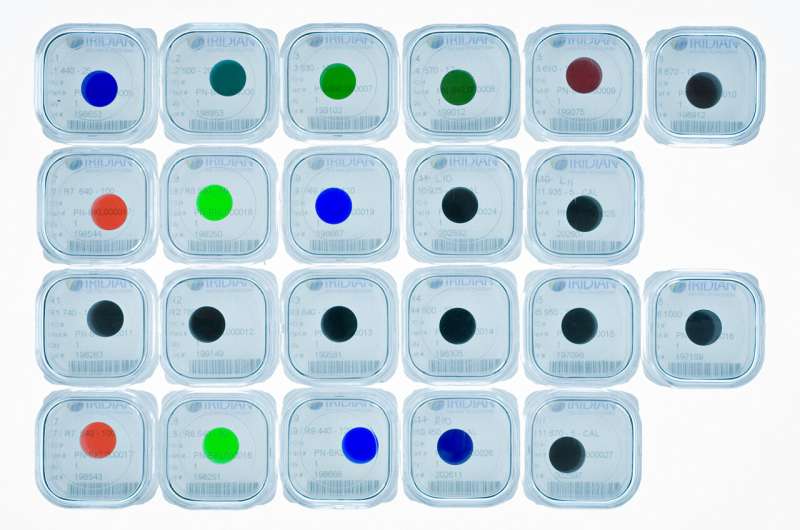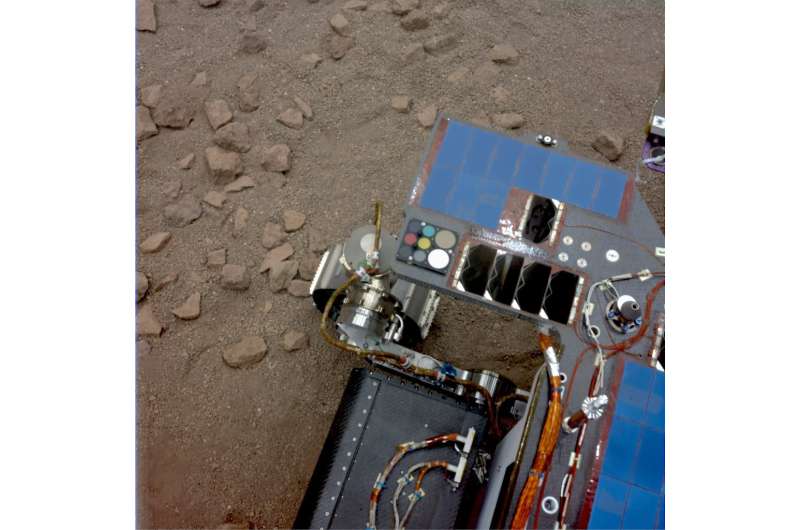Two stereo cameras at the top and at the bottom of the rover's mast—NavCam and LocCam—allow the GTM to 'see' in three dimensions and identify the rocks and slopes ahead. The cameras guide the rover through safe paths and help avoid hazards. Once the rover is on the move, two more sets of cameras—PanCam and CLUPI—come into play to get a whole picture of the site with high resolution imaging. These rover 'eyes' send panoramic and close-up images of the terrain to the operators at the Rover Operations Control Centre (ROCC). The images are essential to map the geological context and to help the scientists decide where the rover should stop and survey the surface in more detail. Credit: Thales Alenia Space
From panoramas to close-ups, from 3D maps to a wheel selfie, the Earth-bound twin of ESA's Rosalind Franklin rover is testing the wide range of photo settings that will deliver the greatest science possible during the ExoMars mission on the Red Planet.
The scientific eyes of the rover are set on the Panoramic Camera suite known as PanCam. The replica atop the mast of the Ground Test Model rover is achieving a level of detail similar to what is expected from Rosalind Franklin in 2023.
The target over the last few months has been the reddish and grainy, sometimes rocky surface of the Mars Terrain Simulator at the ALTEC premises in Turin, Italy.
"Since we will be looking for water and life on Mars, testing Rosalind Franklin's main cameras is particularly important in the search for water-rich minerals," explains Andrew Coates, PanCam principal investigator and Professor at the UCL Mullard Space Science Laboratory in the UK.
PanCam does not have just one pair, but three 'science eyes': one high-resolution and two wide-angle cameras. Their unique color imaging allows for "water-rich mineral identification and outstanding 3D vision, way better than the human eyes. The views from PanCam will give us key insights on the martian landscape," adds Andrew.
From panoramas to close-ups, from 3D maps to a wheel selfie, the Earth-bound twin of ESA’s Rosalind Franklin rover is testing the wide range of photo settings that will deliver the greatest science possible during the ExoMars mission on the Red Planet. The target over the last few months has been the reddish and grainy, sometimes rocky surface of the Mars Terrain Simulator at the ALTEC premises in Turin, Italy. This simulated ‘overflight’ of the Mars-like terrain has been rendered using approximate colour and geometric information. PanCam does not have just one pair, but three ‘science eyes’: one high-resolution and two wide-angle cameras. The two wide-angle cameras are set 50 cm apart and form a stereo pair that images what is in front of the rover from a vantage point about two metres above the ground. Scientists create 3D pictures and depth maps by overlaying simultaneous snapshots. Credit: ESA/ExoMars/PanCam team
Science on top
Engineers have packed as much science as they could into the camera system.
The two wide-angle cameras (WACs) are set 50 cm apart and form a stereo pair that images what is in front of the rover from a vantage point about two meters above the ground. Scientists create 3D pictures and depth maps by overlaying simultaneous snapshots.
"Besides plotting routes where the rover can go, these cameras help us do geology and atmospheric science," says Andrew.
The High Resolution Camera (HRC) has eight times the resolution of the wide-angle cameras to closely examine rock texture and grain size in color.
This powerful camera "will help us investigate very fine details in outcrops, rocks and soils, find the most promising spots to drill, and take images of the samples before they are sent to the rover's laboratory," says Nicole Schmitz, PanCam co-principal investigator responsible for the high-resolution camera at the DLR Institute of Planetary Research, Germany.
Four images taken by PanCam’s wide-angle cameras were stitched together to form this mosaic of the surface of the Mars Terrain Simulator at the ALTEC premises in Turin, Italy. Some footprints and the legs and ramps of Kazachok landing platform model are visible at the top right. Colour has been determined using three of PanCam’s 11 filters. Credit: ESA/ExoMars/PanCam team
Mounted below is the infrared spectrometer (ISEM) that analyzes the geochemistry of the rocks. HRC and ISEM are a well-matched couple. They are co-aligned, so that scientists can see in the HRC images where ISEM took its measurements.
Rainbow eyes
Humans and smartphones can only see colors in visible light. PanCam can 'see' in 19 colors, in the visible and near infrared wavelengths.
Each of the wide-angle cameras has a filter wheel with 11 positions to look at the colors of the rocks and the martian sky.
This special carousel will allow the rover to stare at the Sun, find the amount of dust in the atmosphere and measure the water vapor content during sunsets on Mars.
A calibration target mounted on the rover's solar array top deck, comprising a palette of stained glass similar to that of church windows, will help PanCam get its colors right.
-
ExoMars PanCam filters. Credit: M. de la Nougerede, UCL/MSSL
-
The ExoMars rover's Panoramic Camera (PanCam) includes a calibration target used to aid the calibration and operation of the camera once on Mars, and ‘fiducial markers’ such as the white dot seen on the top solar panel, used to get shapes right. Credit: ESA/ExoMars/PanCam team
Mars-proof
PanCam can withstand much harsher conditions than smartphone cameras on Earth. The hardware can cope with extreme temperatures, from zero degrees during the day down to –120 degrees Celsius during the cold martian nights. The sensors are also resistant to the high radiation environment during the journey to Mars and on the surface of the planet.
"It was challenging to build a robust enough camera with adjustable focus to take high resolution images of very close and far away targets," says Nicole.
Rosalind Franklin can also take a look at herself—a small spherical mirror close to one of the rover's wheels can be used to get a view underneath the rover. The Rover Inspection Mirror, mounted near a rover wheel, will enable PanCam to capture images from underneath the rover.
There is yet another camera which will come in to play for martian shots in upcoming tests. The Close-Up Imager, CLUPI, will provide detailed views of the soil that is churned out by the drilling action. When the drill is in 'stowed' position this camera can also take photos of the landscape to the side of the rover.
Provided by European Space Agency



























